Hopi vs Argentinean Community Comparison
COMPARE
Hopi
Argentinean
Social Comparison
Social Comparison
Hopi
Argentineans
1,478
SOCIAL INDEX
12.3/ 100
SOCIAL RATING
306th/ 347
SOCIAL RANK
8,055
SOCIAL INDEX
78.0/ 100
SOCIAL RATING
90th/ 347
SOCIAL RANK
Argentinean Integration in Hopi Communities
The statistical analysis conducted on geographies consisting of 64,218,473 people shows a perfect negative correlation between the proportion of Argentineans within Hopi communities in the United States with a correlation coefficient (R) of -0.971. On average, for every 1% (one percent) increase in Hopi within a typical geography, there is a decrease of 0.075% in Argentineans. To illustrate, in a geography comprising of 100,000 individuals, a rise of 1,000 Hopi corresponds to a decrease of 75.2 Argentineans.
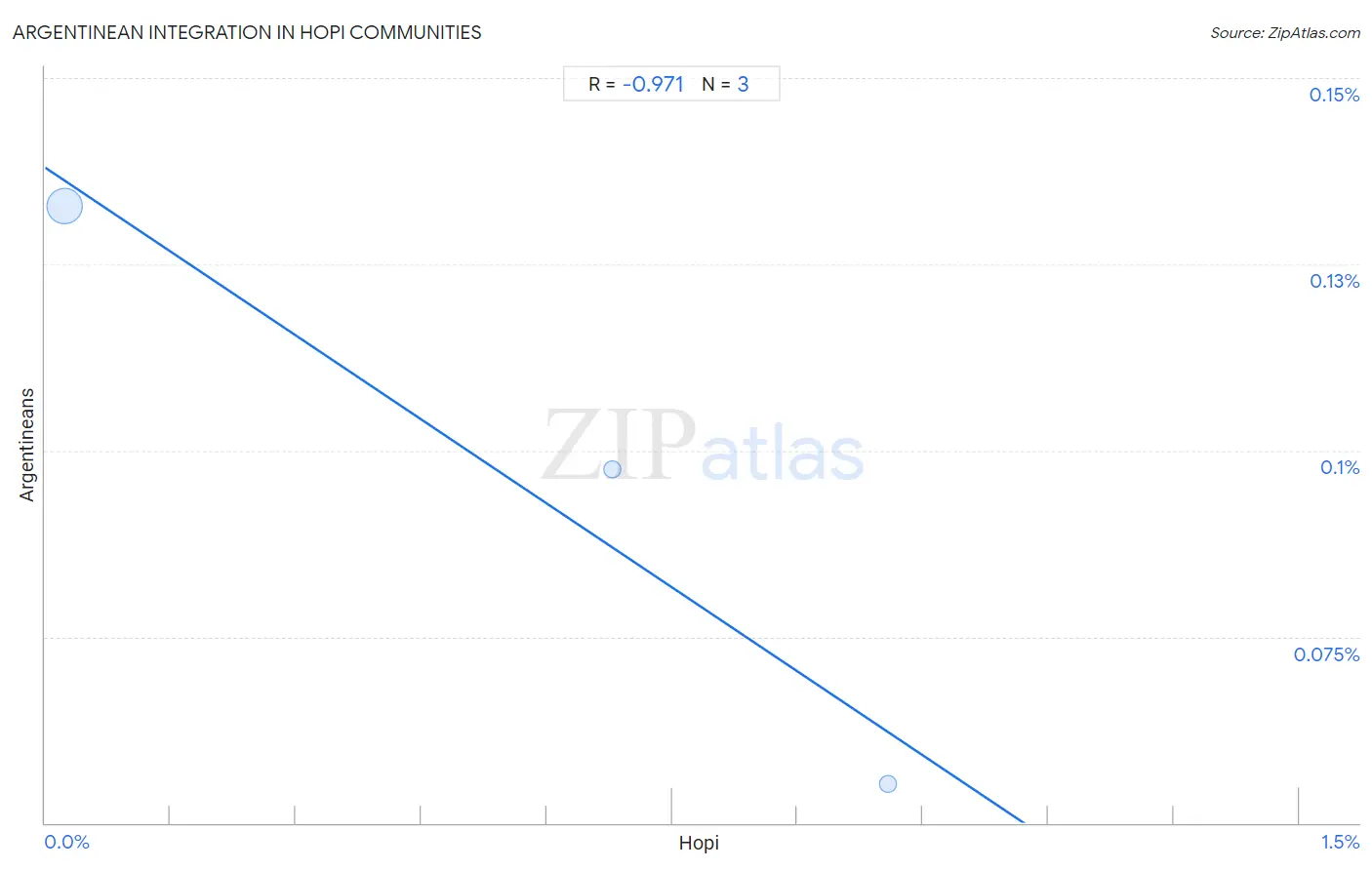
Hopi vs Argentinean Income
When considering income, the most significant differences between Hopi and Argentinean communities in the United States are seen in per capita income ($31,177 compared to $49,862, a difference of 59.9%), median family income ($77,188 compared to $112,665, a difference of 46.0%), and householder income ages 45 - 64 years ($75,562 compared to $110,103, a difference of 45.7%). Conversely, both communities are more comparable in terms of householder income under 25 years ($46,978 compared to $54,154, a difference of 15.3%), median female earnings ($33,932 compared to $41,952, a difference of 23.6%), and householder income over 65 years ($50,925 compared to $65,246, a difference of 28.1%).

| Income Metric | Hopi | Argentinean |
| Per Capita Income | Tragic $31,177 | Exceptional $49,862 |
| Median Family Income | Tragic $77,188 | Exceptional $112,665 |
| Median Household Income | Tragic $65,043 | Exceptional $93,960 |
| Median Earnings | Tragic $36,871 | Exceptional $50,399 |
| Median Male Earnings | Tragic $42,060 | Exceptional $60,117 |
| Median Female Earnings | Tragic $33,932 | Exceptional $41,952 |
| Householder Age | Under 25 years | Tragic $46,978 | Exceptional $54,154 |
| Householder Age | 25 - 44 years | Tragic $75,002 | Exceptional $103,111 |
| Householder Age | 45 - 64 years | Tragic $75,562 | Exceptional $110,103 |
| Householder Age | Over 65 years | Tragic $50,925 | Exceptional $65,246 |
| Wage/Income Gap | Exceptional 20.0% | Tragic 27.0% |
Hopi vs Argentinean Poverty
When considering poverty, the most significant differences between Hopi and Argentinean communities in the United States are seen in single male poverty (27.5% compared to 11.9%, a difference of 130.8%), receiving food stamps (21.6% compared to 10.8%, a difference of 99.1%), and male poverty (20.8% compared to 10.6%, a difference of 96.7%). Conversely, both communities are more comparable in terms of single mother poverty (34.5% compared to 27.2%, a difference of 26.6%), married-couple family poverty (7.1% compared to 5.1%, a difference of 39.5%), and seniors poverty over the age of 75 (18.9% compared to 13.4%, a difference of 40.5%).
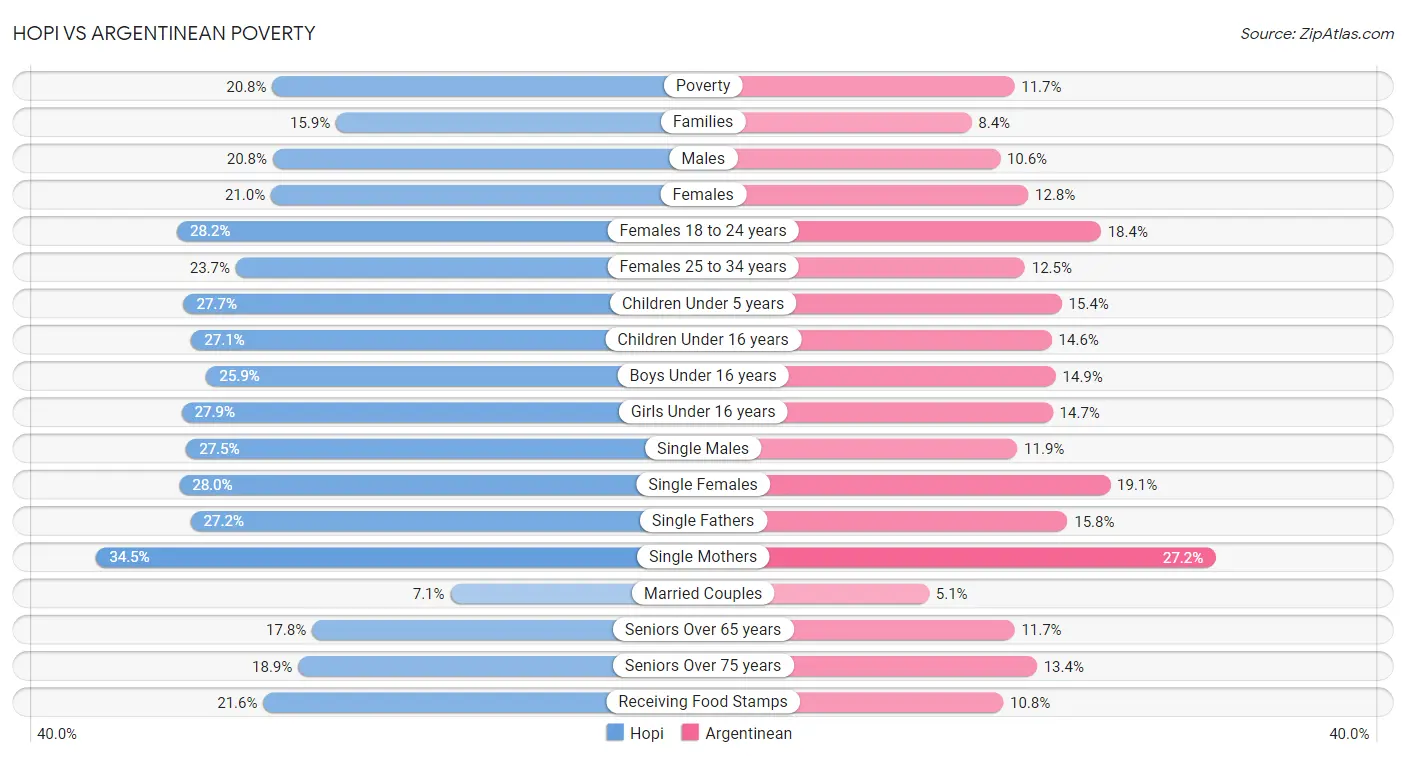
| Poverty Metric | Hopi | Argentinean |
| Poverty | Tragic 20.8% | Excellent 11.7% |
| Families | Tragic 15.9% | Excellent 8.4% |
| Males | Tragic 20.8% | Exceptional 10.6% |
| Females | Tragic 21.0% | Excellent 12.8% |
| Females 18 to 24 years | Tragic 28.2% | Exceptional 18.4% |
| Females 25 to 34 years | Tragic 23.7% | Exceptional 12.5% |
| Children Under 5 years | Tragic 27.7% | Exceptional 15.4% |
| Children Under 16 years | Tragic 27.1% | Exceptional 14.6% |
| Boys Under 16 years | Tragic 25.9% | Exceptional 14.9% |
| Girls Under 16 years | Tragic 27.9% | Exceptional 14.7% |
| Single Males | Tragic 27.5% | Exceptional 11.9% |
| Single Females | Tragic 28.0% | Exceptional 19.1% |
| Single Fathers | Tragic 27.2% | Exceptional 15.8% |
| Single Mothers | Tragic 34.5% | Exceptional 27.2% |
| Married Couples | Tragic 7.1% | Good 5.1% |
| Seniors Over 65 years | Tragic 17.8% | Tragic 11.7% |
| Seniors Over 75 years | Tragic 18.9% | Tragic 13.4% |
| Receiving Food Stamps | Tragic 21.6% | Exceptional 10.8% |
Hopi vs Argentinean Unemployment
When considering unemployment, the most significant differences between Hopi and Argentinean communities in the United States are seen in unemployment among women with children under 6 years (16.8% compared to 7.2%, a difference of 131.8%), unemployment among ages 30 to 34 years (11.9% compared to 5.3%, a difference of 126.4%), and male unemployment (10.8% compared to 5.0%, a difference of 113.8%). Conversely, both communities are more comparable in terms of unemployment among ages 65 to 74 years (5.5% compared to 5.4%, a difference of 1.7%), unemployment among seniors over 65 years (5.3% compared to 5.2%, a difference of 1.9%), and unemployment among ages 60 to 64 years (5.2% compared to 5.0%, a difference of 3.1%).
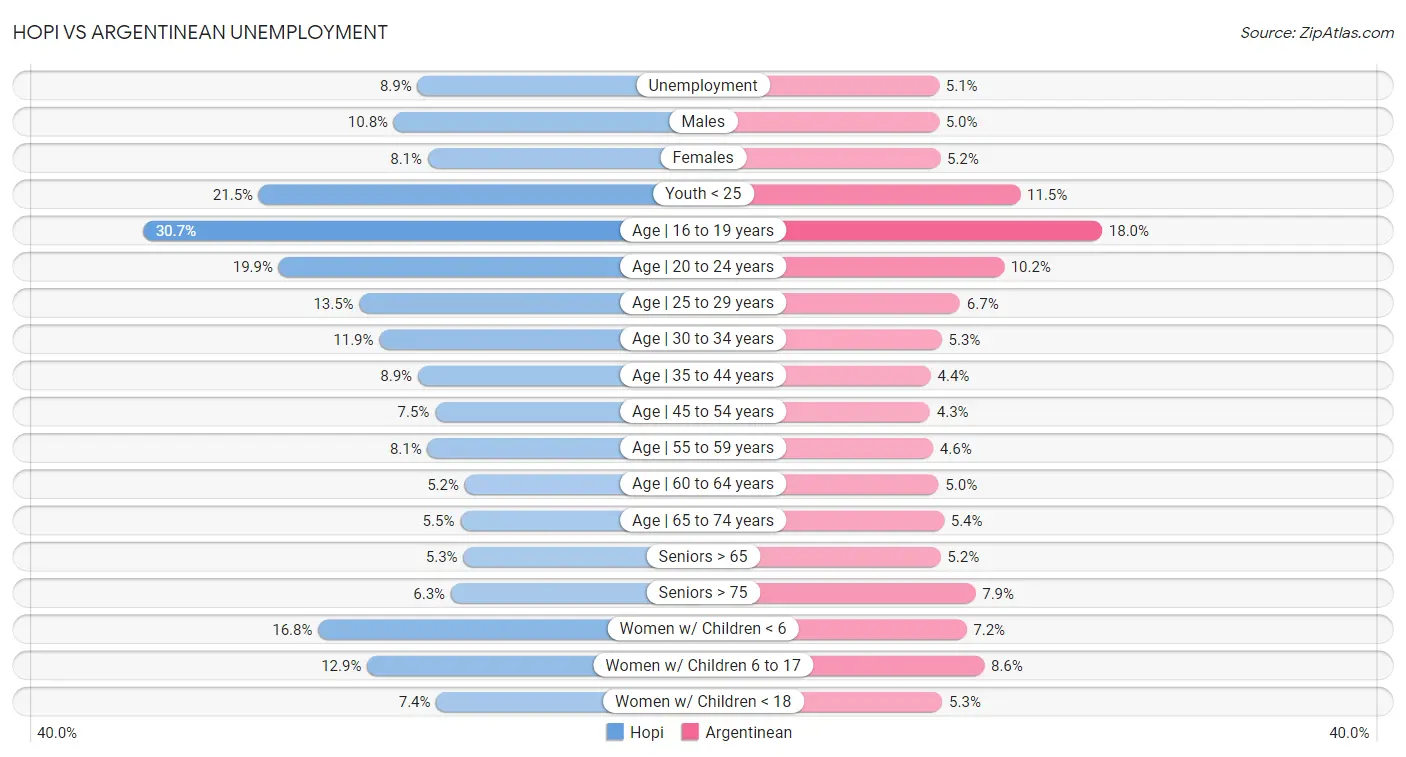
| Unemployment Metric | Hopi | Argentinean |
| Unemployment | Tragic 8.9% | Exceptional 5.1% |
| Males | Tragic 10.8% | Exceptional 5.0% |
| Females | Tragic 8.1% | Good 5.2% |
| Youth < 25 | Tragic 21.5% | Good 11.5% |
| Age | 16 to 19 years | Tragic 30.7% | Poor 18.0% |
| Age | 20 to 24 years | Tragic 19.9% | Good 10.2% |
| Age | 25 to 29 years | Tragic 13.5% | Fair 6.7% |
| Age | 30 to 34 years | Tragic 11.9% | Excellent 5.3% |
| Age | 35 to 44 years | Tragic 8.9% | Exceptional 4.4% |
| Age | 45 to 54 years | Tragic 7.5% | Exceptional 4.3% |
| Age | 55 to 59 years | Tragic 8.1% | Exceptional 4.6% |
| Age | 60 to 64 years | Tragic 5.2% | Tragic 5.0% |
| Age | 65 to 74 years | Tragic 5.5% | Poor 5.4% |
| Seniors > 65 | Tragic 5.3% | Fair 5.2% |
| Seniors > 75 | Exceptional 6.3% | Exceptional 7.9% |
| Women w/ Children < 6 | Tragic 16.8% | Exceptional 7.2% |
| Women w/ Children 6 to 17 | Tragic 12.9% | Exceptional 8.6% |
| Women w/ Children < 18 | Tragic 7.4% | Good 5.3% |
Hopi vs Argentinean Labor Participation
When considering labor participation, the most significant differences between Hopi and Argentinean communities in the United States are seen in in labor force | age > 16 (58.4% compared to 65.7%, a difference of 12.6%), in labor force | age 20-64 (71.7% compared to 80.0%, a difference of 11.6%), and in labor force | age 45-54 (75.0% compared to 83.3%, a difference of 11.1%). Conversely, both communities are more comparable in terms of in labor force | age 16-19 (31.8% compared to 33.3%, a difference of 4.6%), in labor force | age 30-34 (79.3% compared to 85.1%, a difference of 7.4%), and in labor force | age 35-44 (77.0% compared to 84.6%, a difference of 10.0%).

| Labor Participation Metric | Hopi | Argentinean |
| In Labor Force | Age > 16 | Tragic 58.4% | Exceptional 65.7% |
| In Labor Force | Age 20-64 | Tragic 71.7% | Exceptional 80.0% |
| In Labor Force | Age 16-19 | Tragic 31.8% | Tragic 33.3% |
| In Labor Force | Age 20-24 | Tragic 66.0% | Tragic 73.1% |
| In Labor Force | Age 25-29 | Tragic 76.5% | Average 84.7% |
| In Labor Force | Age 30-34 | Tragic 79.3% | Exceptional 85.1% |
| In Labor Force | Age 35-44 | Tragic 77.0% | Excellent 84.6% |
| In Labor Force | Age 45-54 | Tragic 75.0% | Exceptional 83.3% |
Hopi vs Argentinean Family Structure
When considering family structure, the most significant differences between Hopi and Argentinean communities in the United States are seen in births to unmarried women (50.8% compared to 30.0%, a difference of 69.5%), single mother households (8.5% compared to 5.8%, a difference of 45.0%), and single father households (2.8% compared to 2.1%, a difference of 31.9%). Conversely, both communities are more comparable in terms of family households (65.3% compared to 65.0%, a difference of 0.43%), family households with children (25.2% compared to 27.6%, a difference of 9.5%), and divorced or separated (13.2% compared to 11.9%, a difference of 10.8%).

| Family Structure Metric | Hopi | Argentinean |
| Family Households | Exceptional 65.3% | Exceptional 65.0% |
| Family Households with Children | Tragic 25.2% | Good 27.6% |
| Married-couple Households | Tragic 36.7% | Exceptional 47.5% |
| Average Family Size | Exceptional 3.60 | Average 3.23 |
| Single Father Households | Tragic 2.8% | Exceptional 2.1% |
| Single Mother Households | Tragic 8.5% | Exceptional 5.8% |
| Currently Married | Tragic 36.5% | Good 47.1% |
| Divorced or Separated | Tragic 13.2% | Excellent 11.9% |
| Births to Unmarried Women | Tragic 50.8% | Exceptional 30.0% |
Hopi vs Argentinean Vehicle Availability
When considering vehicle availability, the most significant differences between Hopi and Argentinean communities in the United States are seen in no vehicles in household (13.7% compared to 11.2%, a difference of 22.7%), 4 or more vehicles in household (6.9% compared to 6.2%, a difference of 11.6%), and 2 or more vehicles in household (49.0% compared to 54.5%, a difference of 11.2%). Conversely, both communities are more comparable in terms of 1 or more vehicles in household (86.4% compared to 88.9%, a difference of 2.9%), 3 or more vehicles in household (18.2% compared to 18.9%, a difference of 4.4%), and 2 or more vehicles in household (49.0% compared to 54.5%, a difference of 11.2%).

| Vehicle Availability Metric | Hopi | Argentinean |
| No Vehicles Available | Tragic 13.7% | Tragic 11.2% |
| 1+ Vehicles Available | Tragic 86.4% | Tragic 88.9% |
| 2+ Vehicles Available | Tragic 49.0% | Poor 54.5% |
| 3+ Vehicles Available | Tragic 18.2% | Poor 18.9% |
| 4+ Vehicles Available | Exceptional 6.9% | Fair 6.2% |
Hopi vs Argentinean Education Level
When considering education level, the most significant differences between Hopi and Argentinean communities in the United States are seen in bachelor's degree (25.3% compared to 43.3%, a difference of 71.1%), master's degree (10.9% compared to 18.2%, a difference of 67.2%), and professional degree (3.6% compared to 5.9%, a difference of 62.5%). Conversely, both communities are more comparable in terms of 9th grade (94.8% compared to 94.8%, a difference of 0.0%), 4th grade (97.7% compared to 97.5%, a difference of 0.18%), and 5th grade (97.5% compared to 97.3%, a difference of 0.18%).
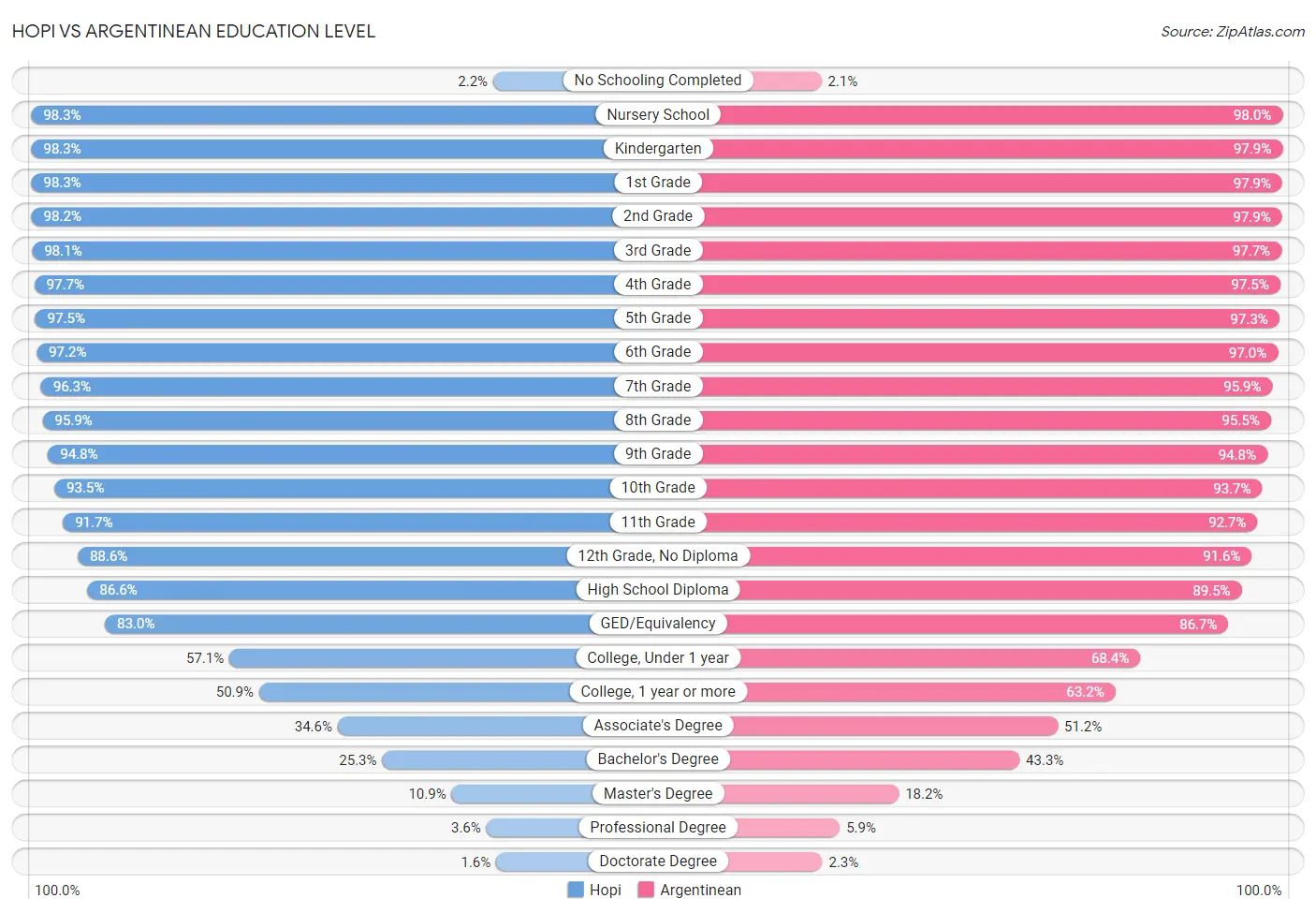
| Education Level Metric | Hopi | Argentinean |
| No Schooling Completed | Poor 2.2% | Average 2.1% |
| Nursery School | Exceptional 98.3% | Average 98.0% |
| Kindergarten | Exceptional 98.3% | Average 97.9% |
| 1st Grade | Exceptional 98.3% | Average 97.9% |
| 2nd Grade | Exceptional 98.2% | Average 97.9% |
| 3rd Grade | Exceptional 98.1% | Average 97.7% |
| 4th Grade | Excellent 97.7% | Fair 97.5% |
| 5th Grade | Good 97.5% | Fair 97.3% |
| 6th Grade | Good 97.2% | Fair 97.0% |
| 7th Grade | Excellent 96.3% | Fair 95.9% |
| 8th Grade | Good 95.9% | Fair 95.5% |
| 9th Grade | Fair 94.8% | Fair 94.8% |
| 10th Grade | Fair 93.5% | Average 93.7% |
| 11th Grade | Tragic 91.7% | Good 92.7% |
| 12th Grade, No Diploma | Tragic 88.6% | Excellent 91.6% |
| High School Diploma | Tragic 86.6% | Good 89.5% |
| GED/Equivalency | Tragic 83.0% | Excellent 86.7% |
| College, Under 1 year | Tragic 57.1% | Exceptional 68.4% |
| College, 1 year or more | Tragic 50.9% | Exceptional 63.2% |
| Associate's Degree | Tragic 34.6% | Exceptional 51.2% |
| Bachelor's Degree | Tragic 25.3% | Exceptional 43.3% |
| Master's Degree | Tragic 10.9% | Exceptional 18.2% |
| Professional Degree | Tragic 3.6% | Exceptional 5.9% |
| Doctorate Degree | Tragic 1.6% | Exceptional 2.3% |
Hopi vs Argentinean Disability
When considering disability, the most significant differences between Hopi and Argentinean communities in the United States are seen in disability age under 5 (4.6% compared to 1.2%, a difference of 289.1%), disability age 35 to 64 (13.9% compared to 9.4%, a difference of 47.7%), and vision disability (2.9% compared to 2.0%, a difference of 45.2%). Conversely, both communities are more comparable in terms of cognitive disability (17.9% compared to 16.6%, a difference of 7.9%), disability age over 75 (52.9% compared to 46.2%, a difference of 14.5%), and disability age 5 to 17 (5.9% compared to 5.1%, a difference of 16.3%).
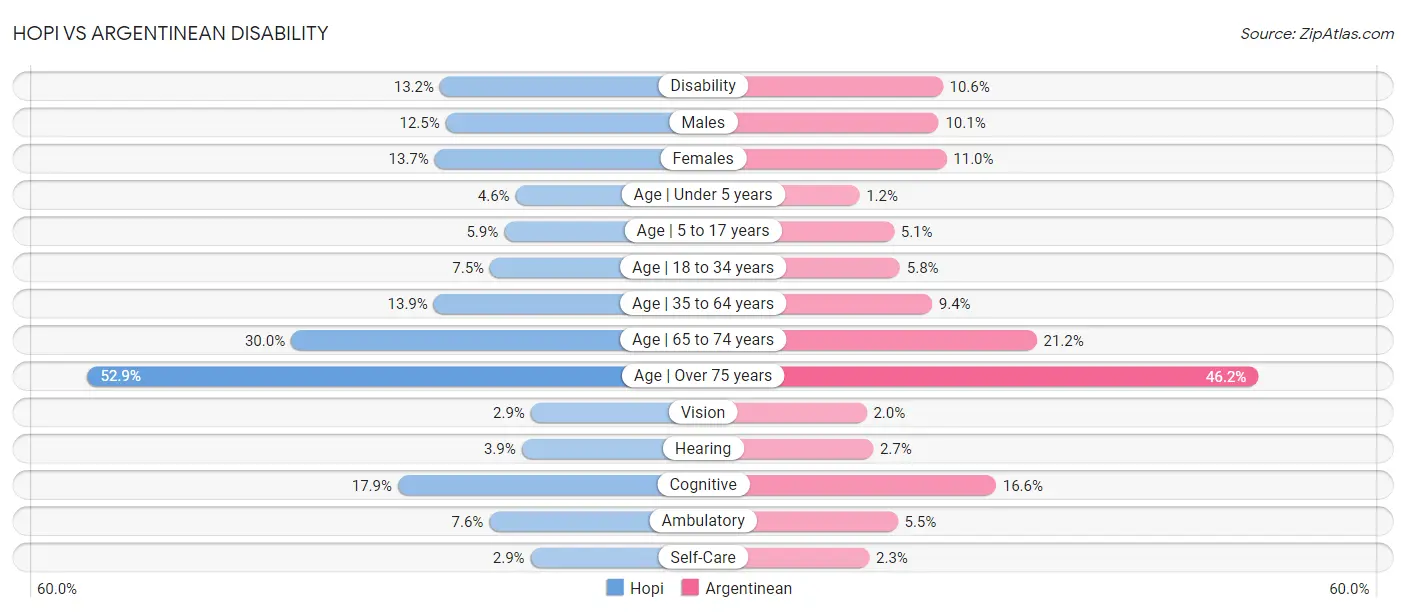
| Disability Metric | Hopi | Argentinean |
| Disability | Tragic 13.2% | Exceptional 10.6% |
| Males | Tragic 12.5% | Exceptional 10.1% |
| Females | Tragic 13.7% | Exceptional 11.0% |
| Age | Under 5 years | Tragic 4.6% | Excellent 1.2% |
| Age | 5 to 17 years | Tragic 5.9% | Exceptional 5.1% |
| Age | 18 to 34 years | Tragic 7.5% | Exceptional 5.8% |
| Age | 35 to 64 years | Tragic 13.9% | Exceptional 9.4% |
| Age | 65 to 74 years | Tragic 30.0% | Exceptional 21.2% |
| Age | Over 75 years | Tragic 52.9% | Exceptional 46.2% |
| Vision | Tragic 2.9% | Exceptional 2.0% |
| Hearing | Tragic 3.9% | Exceptional 2.7% |
| Cognitive | Tragic 17.9% | Exceptional 16.6% |
| Ambulatory | Tragic 7.6% | Exceptional 5.5% |
| Self-Care | Tragic 2.9% | Exceptional 2.3% |